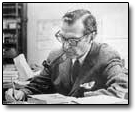
James
Bond Homepage
007museum@telia.com
Donations/Gåvor
James
Bond Museum
EON
Productions movies
1. Dr
No 1962
2. From Russia With
Love 1963
3. Goldfinger 1964
4. Thunderball 1965
5. You
Only Live Twice
1967
6. On Her Majesty`s Secret Service
7. Diamonds Are Forever1971
8. Live And Let Die1973
9. The Man With The Golden Gun
10.The Spy Who Loved Me
11.Moonraker 1979
12.For Your Eyes Only 1981
13.Octopussy
1983
14.A View To A Kill
1985
15.The Living Daylights
1987
16.Licence To Kill 1989
17.Goldeneye1995
18.Tomorrow Never Dies1997
19.The World Is Not Enough
20.Die Another
Day 2002
21.Casino Royale 2006
22.Quantum Of Solace
2008
23.James Bond 23
24.James Bond
24
Not included in
Bondserie or
EON Productions
Casino Royale 1954
Casino
Royale 1967
Never Say Never Again 1983
Producer
Albert
"Cubby"Broccoli
Harry
Saltzman
Barbara Broccoli
Michael G,Wilson
Writers to all Bond books
Ian Fleming
Amis Kingsley
Raymond Benson
John Gardner
Charlie Higson
Sebastian Faulks
Jeffery Deaver
Neal Purvis
screenwriter
Robert Wade
screenwriter
Bondbooks
James Bond actors
Barry
Nelson
Sean Connery
George Lazenby
Roger Moore
Timothy Dalton
Pierce Brosnan
Daniel Craig
James Bond Composers
Monty Norman 1
John Barry 11
George Martin 1
Marvin Hamlisch 1
Bill Conti 1
Michael Kamen 1
Eric Serra 1
David Arnold 5
James Bond Music
22 Best Bondsoundtrack
Bondgirls
Honey Ryder Ursula Andress
Britt
Ekland
Izabella Scorupco
Maud Adams
Kristina
Wayborn
Mary
Stavin
Halle
Berry JINX
Bond Villians
Jaws (Rickard Kiel)
Pinewood Studios
Ian Flemings Books
Casino Royale (1953)
Live And Let Die (1954)
Moonraker (1955)
Diamonds Are Forever (1956)
From Russia With Love (1957)
Doctor No (1958)
Goldfinger (1959)
For Your Eyes Only (1960)
Thunderball (1961)
The Spy Who Loved Me (1962)
On Her Majesty's Secret Service (1963)
You Only Live Twice (1964)
The Man With The Golden Gun (1965)
Octopussy and the Living Daylights (1966)
The Royal flatbed typewriters were the only unique
design that the Royal company put on the market. But when it came to
work horses, the company introduced one price winner after the other for
decades. And from the 1930s on, the line included portables. The Quiet
De Luxe was the flagship for many years.
In the late 1940s Royal had the Quiet De Luxe redesigned
by Henry Dreyfuss who came up with the model shown on this page. It is
not the kind of machine that deserves a place in a museum for antique
typewriters, except that this one is... made of gold. Not solid gold,
but plated.
The gold-plated machine was produced in a limited edition
and sold at a considerable price. Apparently, one of them was owned by
author Ian Fleming.
Courtesy of: Robert collection 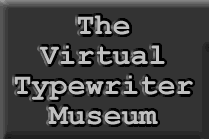
Ian Fleming, the father of James Bond
Ian Fleming was born in 1908. He was a British writer
who wrote books about an English spy called James Bond with the codename
007.
The 00 stands for that he’s got license to kill anyone, anytime,
anywhere.
At the time of his writing the cold war was at its peak.The cold war was
also one reason why his books became as successful as they did.
Ian Flemming wrote twelve books about the spy James Bond.
In 1964 Ian Fleming died and at that time only two James Bond films had
been produced. It was the movies that made James Bond famous worldwide.
James Bond Actors
There’s been five actors playing Mr Bond more than one
time:
Sean Connery, Roger Moore, Timothy Dalton, Pierce Brosnan and Daniel Craig
Many people have different opinions which of them is the real Bond.
Most of them say it’s Sean Connery because he was first playing Bond.
I think Pierce Brosnan is best as James Bond
James Bond
James Bond works for the British government and gets his
missions from them.
The stories about James Bond are all about how he tricks all his enemies
and gets all the nice women. His enemies are often Russian criminals.
This seems to be a common action story but the Bond films are special.
James Bond is never stressed or scared. Even if he is in a very critical
situation like jumping after an aeroplane which is falling to the ground
climb into the plane and fly away with it.
This seems to be very dangerous but for Mr Bond it’s a piece of cake.
At his base in London somewhere he’s got this guy who helps him called
Q. He’s participated in almost every bond movie.
He produces lots of gadgets in his laboratory, which are supposed to help
Mr Bond on his missions. In every film he gets a new car from Q.
Q always tells bond to be careful with the car and he’s like yeah yeah
and crashes the car in every film.
We also have this woman called moneypenny, who seems to be in love with Mr
Bond but never gets him.
Another classical character in the bond films is one of his enemies who is
a very big man called Jaws. He’s got metal teeth and is very strong but
he’s not very smart so he always screws up and falls out of aeroplanes
without a parachute but always survives. He never says anything and no one
knows why. One exemption for that is in the film moonraker when he becomes
friend with Mr Bond says cheers with a champagne glass in his hands.
Mr Bond also has some things he says in every film like “Hi my name is
Bond, James Bond” and “I want dry martini shaken not stirred”.
All these things are classical for almost every bond film.
Some other classical things in the bond films are all the sponsors that
want their names in the film. In the early movies Mr Bond always drove an
Aston Martin car but in today’s movies he drives a BMW.
He’s always got an Ericsson cellphone and he always drinks Bollinger
Champagne.
Why did these companies pay money to have their name in the film?
Some people have Mr Bond as an idol and they want to be alike him and
hopefully they will use the same champagne or the same car as he does.
That may sound very farfetched but they actually make more money out of
this then they pay for having their name in the films.
|
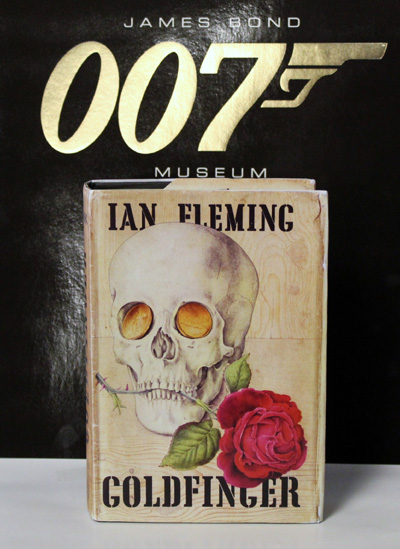 FIRST
EDITION 1959 IAN FLEMING JAMES BOND GOLDFINGER
FIRST
EDITION 1959 IAN FLEMING JAMES BOND GOLDFINGER
GOLDFINGER, just one of the James Bond first editions
Published by Jonathan Cape in London in
1959, with the essential 'First Published 1959' to the inner page, with
no later titles stated, this is not the book club edition,
not the US edition and not a later printing - this is
the first printing of the seventh James Bond adventure, Goldfinger.
When
investing in any rare and collectable book, the condition of the book is
of paramount importance and will help determine its value. This book is in Very
Good condition while the jacket is a reproduction of the original
jacket.
Bound in its original cloth
boards, with the skull with golden eyes to the front board and gilt
lettering to the spine, intact if slightly faded, this is a nice copy of
this first edition especially when you consider the condition of many of
the remaining first editions. The boards are clean with two very light
barely noticeable white marks to the rear. There is a lean to the spine
but externally this is otherwise a pleasing book. There is a small
inscription to the front endpaper but not much else - the pages
are intact (none missing); the book is not ex-library; the pages are
almost all clean with some foxing and one or two light blemishes to a few
pages. There is the remains of sellotape and a large tear to page 32/33.
This affects the one page only. There is foxing to the page block edge.
Overall though, a pleasing book.
The jacket is a facsimile
reproduction of the first issue dust jacket.
With collectable copies of
this book valued at up to £750.
People collect rare titles
for all sorts of reasons. Some people simply love books. Others see first
editions as investment opportunities. In just the past few years
alone, an increase in demand for rare Ian Fleming titles has seen the
value of collectable copies of first editions like The Spy Who Loved
Me almost double in value. From Casino Royale to Goldfinger,
For Your Eyes Only to Thunderball, The Man with the
Golden Gun to Octopussy, each Ian Fleming Jonathan Cape
first edition represents an investment for the future.
GOLDFINGER
Published in 1959 by Jonathan Cape in London
Black cloth gilt lettering , skull embossed on front board
Verso title page states "First Published 1959"
Dustwrapper priced at 15s
Plain white endpapers 318 pages
The 1st print run was 24,000 copies
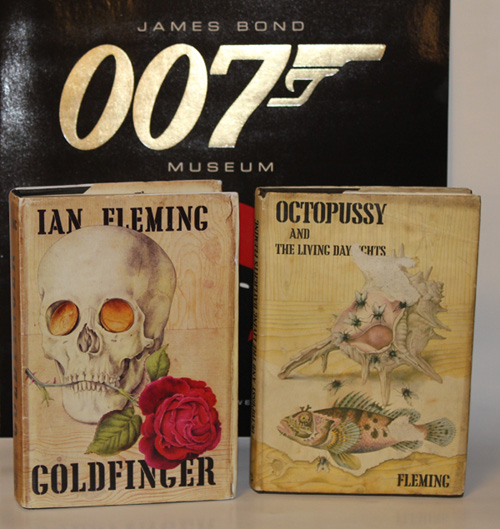
Casino Royale (1953)
Live And Let Die (1954)
Moonraker (1955)
Diamonds Are Forever (1956)
From Russia With Love (1957)
Doctor No (1958)
GOLDFINGER (1959)
For Your Eyes Only (1960)
THUNDERBALL
(1961)
THE
SPY WHO LOVED ME (1962)
On Her Majesty's Secret Service (1963)
You Only Live Twice (1964)
The Man With The Golden Gun (1965)
Octopussy and the Living Daylights (1966)
Ian Fleming's James Bond Titles
Title Published Film Released
1. Casino Royale 1953 1967 and 2006
2. Live and Let Die 1954 1973
3. Moonraker 1955 1979
4. Diamonds Are Forever 1956 1971
5. From Russia With Love 1957 1963
6. Doctor No 1958 1962
7. Goldfinger 1959 1964
8. For Your Eyes Only (short stories) 1960
From A View To A Kill 1985
For Your Eyes Only 1981
Quantum of Solace 2008
Risico
The Hildebrand Rarity
9. Thunderball 1961 1965
10. The Spy Who Loved Me 1962 1977
11. On Her Majesty's Secret Service 1963 1969
12. You Only Live Twice 1964 1967
13. The Man With The Golden Gun 1965 1974
14. Octopussy & The Living Daylights (short stories) 1966
Octopussy 1983
The Living Daylights 1987
The Property Of A Lady
Ian Fleming's Non-Bond books
Title Published Film released
Chitty Chitty Bang Bang 1964 1968
Thrilling Cities 1963
The Diamond Smugglers 1957
"I wanted the simplest, dullest,
plainest-sounding name I could think of. James Bond seemed perfect."
-Ian Fleming
While he may be the world's most famous,
glamorous secret agent, let's face it, his name is pretty dull. In a way
it is fitting, Fleming achieved exactally what he wanted to with the name.
He actually found it sitting on his bookshelf in the author of a book
entitled "Bird's Of The West Indies." And like that, history was
made!
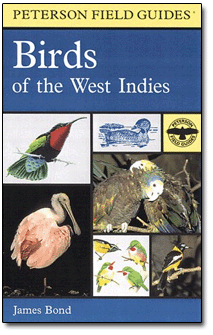
James Bond (January 4, 1900 – February 14, 1989) was a leading American ornithologist whose name was appropriated by writer Ian Fleming for his fictional spy James Bond.
|
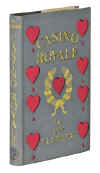
Published 13th April 1953 by Jonathan Cape in London |
CASINO ROYALE
1953
Published in 1953 by Jonathan Cape in London
Black cloth & red lettering & heart on front board
Verso title page states "First Published 1953"
Dust wrapper priced at 10s.6d
Rear panel has pencil drawing of Ian Fleming by Bartlett,
with blurb about Fleming's life below
Front flap has blurb with jacket credit immediately below
There should be NO Times review
Rear flap is blank but for title, author, Cape & price
in bottom left corner
4,728 copies were bound up, a large number of which
went to public libraries
|
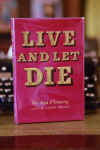
Published 5th May 1954 by Jonathan Cape
in London
|
LIVE
AND LET DIE 1954
Published in 1954 by Jonathan Cape in London
Black cloth & gilt lettering & gilt medallion on
front board
Verso title page states "First Published 1954"
Dust wrapper priced at 10s.6d
There are 3 states of 1st edition dust wrappers
First State : No credit for jacket design on front
flap
Second State : 2 line credit is positioned midway
between blurb end & price
Third State : 2 line credit is positioned directly
under the blurb
7,500 copies were printed of the 1st edition
|
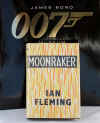
Published 7th April 1955 by Jonathan Cape in
London |
MOONRAKER
1955
Published in 1955 by Jonathan Cape in London
Black cloth & silver lettering
Verso title page states "First Published 1955"
Dust wrapper priced at 10s.6d
There is a "semi issue point" Page 10 last line shoot
/ shoo
No priority established but I believe shoot to be
preferable
There are also 2 paper thicknesses
One text block measures 19mm whilst the other is 15mm
The 15mm is poorer quality and prone to browning
The 1st print run was 9,900 copies
|
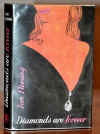
Published 26th March 1956 by Jonathan Cape in
London
|
Diamonds
Are Forever 1956
Published in 1956 by Jonathan Cape in London
Black cloth & silver lettering
Verso title page states "First Published 1956"
Dust wrapper priced at 12s.6d
The 1st print run was 14,700 copies
|

Published 8th April 1957 by Jonathan Cape in
London
|
From
Russia With Love 1957
Published in 1957 by Jonathan Cape in London
Black decorated cloth
Verso title page states "First Published 1957"
Dustwrapper priced at 13s.6d
The 1st set of sheets were of poor print quality and
rejected by Cape
These were later sent to the book club
This means that, theoretically, the '1st printing' is the
book club edition
Note: The Cape sheets have Cape name and logos on title
page
Those with 'Book Club' are later printings and the above
does not apply
The Cape edition was published first, and is the first
edition
The 1st print run was 15,000 copies
|
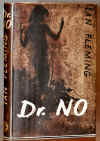
Published 31st March 1958 by Cape in London
|
Dr No (1958)
Published in 1958 by Jonathan Cape in London
Black cloth with or without "dancing girl"
figure
Verso title page states "First Published 1958"
Dust jacket priced at 13s.6d
There is no priority established for the dancing girl
From experience, the ones without the figure appear to be
rarer
The 1st print run was 20,000 copies
|
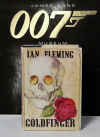
Published 23rd March 1959 by Jonathan Cape in
London
|
GOLDFINGER
1959
Published in 1959 by Jonathan Cape in London
Black cloth gilt lettering , skull embossed on front board
Verso title page states "First Published 1959"
Dustwrapper priced at 15s
The 1st print run was 24,000 copies
|
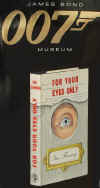
Published 11th April 1960 by Jonathan Cape in
London
|
For Your Eyes Only (1960)
Published in 1960 by Jonathan Cape in London
Black cloth, gilt lettering , eye design on front board
Verso title page states "First Published 1960"
Dust wrapper priced at 15s
The 1st print run was 21,712 copies
|
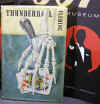
Published 27th March 1961 by Jonathan Cape in
London
|
THUNDERBALL
(1961)
Published in 1961 by Jonathan Cape in London
Black cloth, gilt lettering , skeletal hand on front board
Verso title page states "First Published 1961"
Dust wrapper priced at 15s
The 1st print run was 50,938 copies
|
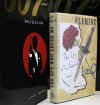
Published 16th April 1962 by Jonathan Cape in
London
|
THE
SPY WHO LOVED ME (1962)
Published in 1962 by Jonathan Cape in London
Black cloth, silver lettering , with a dagger on the front
board
Verso title page states "First Published 1962"
Dust wrapper priced at 15s
There are copies with a quad mark
between the E & M of Fleming on the title page
This mark is not on the proof sheets and was just a spacer
that worked loose during the print run
No priority officially established and not of
bibliographical importance, but copies with quad mark are
very much scarcer and consequently fetch a premium
The 1st print run was 30,000 copies
|
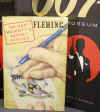
Published 1st April 1963 by Jonathan Cape in
London
|
On Her Majesty's Secret Service (1963)
Published in 1963 by Jonathan Cape in London
Black cloth, silver lettering , track design on front
board
Verso title page states "First Published 1963"
Dust wrapper priced at 16s
The 1st print run was 45,000 copies
There is a signed limited edition of this title
250 numbered copies - but unnumbered copies also turn up
Jonathan Cape's records suggest there should be approx 43
unnumbered
Ten of these were given to Ian Fleming the rest intended
as presentation copies
The 1st print run was 45,000 copies
|

Published 16th March 1964 by Jonathan Cape in
London
|
You
Only Live Twice (1964)
Published in 1964 by Jonathan Cape in London
Black cloth, silver lettering , Japanese lettering on
front board
Verso title page states "First Published 1964"
Note: "First Published March 1964" is second
state
Dust wrapper priced at 16s
The 1st print run was 56,000 copies
|

Published 1st April 1965 by Jonathan Cape in
London
|
THE MAN WITH THE GOLDEN GUN
(1965)
Published in 1965 by Jonathan Cape in London
Black cloth, gilt lettering
Verso title page states "First Published 1965"
Copies exist with a gun in gilt on the front boards
Dust wrapper priced at 18s
The 1st print run was 82,000 copies
|
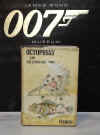
Published 23rd June 1966 by
Jonathan Cape in
London
|
Octopussy and the Living Daylights (1966)
Published in 1966 by Jonathan Cape in London
Black cloth, gilt lettering
Verso title page states "First Published 1966"
This title was repriced in order to clear remaining copies
Contrary to popular opinion it was not actually
remaindered
A London bookseller bought the last 32,000 copies directly.
He gradually sold them for £1.50 each
Copies with unclipped jackets and
no signs of a price sticker are preferred
Dust wrapper priced at 10s.6d
The 1st print run was 50,000 copies
|
|






![]()
![]()
![]()
![]()
![]()
![]()
![]()
![]()
![]()
![]()
![]()


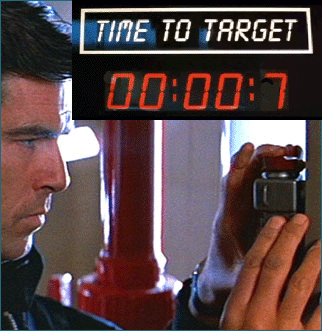
![]()




